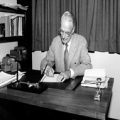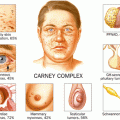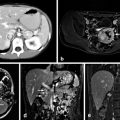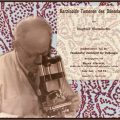Dr. George W. Crile. (From [5]. Reprinted with permission, Cleveland Clinic Center for Medical Art & Photography © 2014. All Rights Reserved)
Introduction
Born in 1864 in Chili, Ohio, Dr. George Washington Crile became one of the most distinguished surgeons of the early twentieth century worldwide [1]. He was a founder and the second president of the American College of Surgeons, and cofounder of the Cleveland Clinic . He served in the Spanish American War and in World War I, where he became very interested in shock. He was the head of experimental clinical research for the American Expeditionary Force, and ultimately rose to the rank of general. He is credited with giving the first human blood transfusion. He designed a hemostat which bears his name. He developed the use of narcotics and regional anesthesia with general anesthesia, now called “balanced anesthesia.” For his work on “shockless surgery,” he received a gold medal from the National Institute of Social Sciences. In World War II, the SS George Crile was named after him. A lunar crater “Crile” also bears his name. These latter two honors certainly attest to the high esteem in which he was held.
All of his accomplishments are beyond the scope of this chapter. We focus on his greatness as a surgeon, especially on the early development of an effective operation for thyrotoxicosis at a time when this disease was associated with a very high mortality rate. Furthermore, we discuss how he translated his experimental work on shock into clinical practice to benefit the most difficult patients with recurrent hyperthyroidism from Graves’ disease . The brain, he felt, was central as a cause of Graves’ disease; fear and other harmful emotions were to be avoided. “Stealing the thyroid” and using adrenal denervation to produce a state of anociassociation and shockless surgery were used in the treatment of the most serious cases of recurrent thyrotoxicosis. These terms and the procedures that he used are described in detail.
Shock and Anociassociation
For much of his life, Dr. Crile was interested in the mechanism of shock. He wrote that low blood pressure, failing respiration, changes in chemistry of the blood, mental and muscular weakness, and the exudation of serum through the walls of the blood vessels were not the cause of shock, but rather the result of shock [2]. He found that these manifestations of shock could be almost completely prevented by the use of morphine, nitrous oxide, and spinal anesthesia. Thus, he felt that the causes of shock were psychic or neural impulses reaching the brain. By preventing the brain from receiving these stimuli, called a state of anociassociation, one could prevent the manifestations of shock.
The adrenal gland and adrenaline were very important in changes in blood pressure and shock during operations in man [3]. Crile realized that strong emotions, such as fear before an operation, might produce shock and severe complications of the operation. He attempted to allay fear by “psychic suggestion,” and when an operation was necessary, by anesthetizing the operative area by use of local anesthesia before giving general anesthesia. Thus, by blocking nerve communication between the affected part and the brain by use of local or regional anesthesia, he could achieve a shockless operation. He used these principles in the treatment of severe cases of thyrotoxicosis .
Thyroid Surgery and Graves’ Disease
The 1920s were a period of great excitement for thyroid surgeons . In 1922, Dr. Henry Plummer showed that when patients with Graves’ disease were given iodine, their hyperthyroidism could be partially controlled, and thyroidectomy was made relatively safe [4]. Prior to that time, thyroid storm and bleeding made this operation extremely dangerous. Only the most courageous surgeon would operate on a patient with Graves’ disease. Now for the first time, many patients who were being followed were considered operative candidates. Furthermore, the Cleveland area and the Midwest were considered a “goiter belt” and huge nontoxic goiters were common. Iodine supplementation to prevent and treat goiters was not yet common in medical practice.
Dr. Crile was perhaps one of the most prolific surgeons of his time [5]. He and his group were ready for an ever-increasing number of thyroid operations. In 1927, these reached a peak when 2700 thyroid operations were performed in a single year. The largest number of operations performed by Crile in 1 day was 35. Throughout his career, Crile performed more than 25,000 thyroid operations. It has been written that “the original (Cleveland) Clinic and Hospital buildings were paid for mainly by the receipts from thyroidectomies.” His operative techniques and procedures are briefly discussed in the following sections.
Fear, Thyroid Storm, and “Stealing the Thyroid”
The greatest danger when operating on a thyrotoxic patient in the 1920s was thyroid storm or crisis . The pulse soared, the heart often fibrillated, the temperature rose to 105 or 106 °F, and the patient “literally consumed himself in the fire of metabolism” [5]. Ice bags and oxygen were applied. There were no medications to slow the pulse. There were no corticosteroids for possible adrenal insufficiency. The peak of a thyroid crisis occurred on the second night after operation, and then subsided if the patient were to survive. These events followed general anesthesia, an operation, an infection, or a frightening episode.
Crile believed that emotion, especially fear, was the cause of thyroid storm [3, 5]. He developed a system to prevent the patient’s fear which became known as “stealing the thyroid.” The thyrotoxic patient consented to operation but was never told when the operation would take place. Each morning, breakfast was held and the anesthetist would come into the room and administer nitrous oxide–oxygen analgesia by mask—enough to make the patient giddy and confused. On the morning when the operation was to be done, the routine was the same, but deeper analgesia was obtained. The thyroid operation was performed most often in the patient’s bed. The patient never had a chance to become afraid. A modification of this system was sometimes used by other surgeons. Each day saline was injected intravenously into a patient’s arm vein. On the day when the operation was to be performed, morphine, other sedatives, or an anesthetic agent was injected, and the patient was operated upon .
Stay updated, free articles. Join our Telegram channel

Full access? Get Clinical Tree







